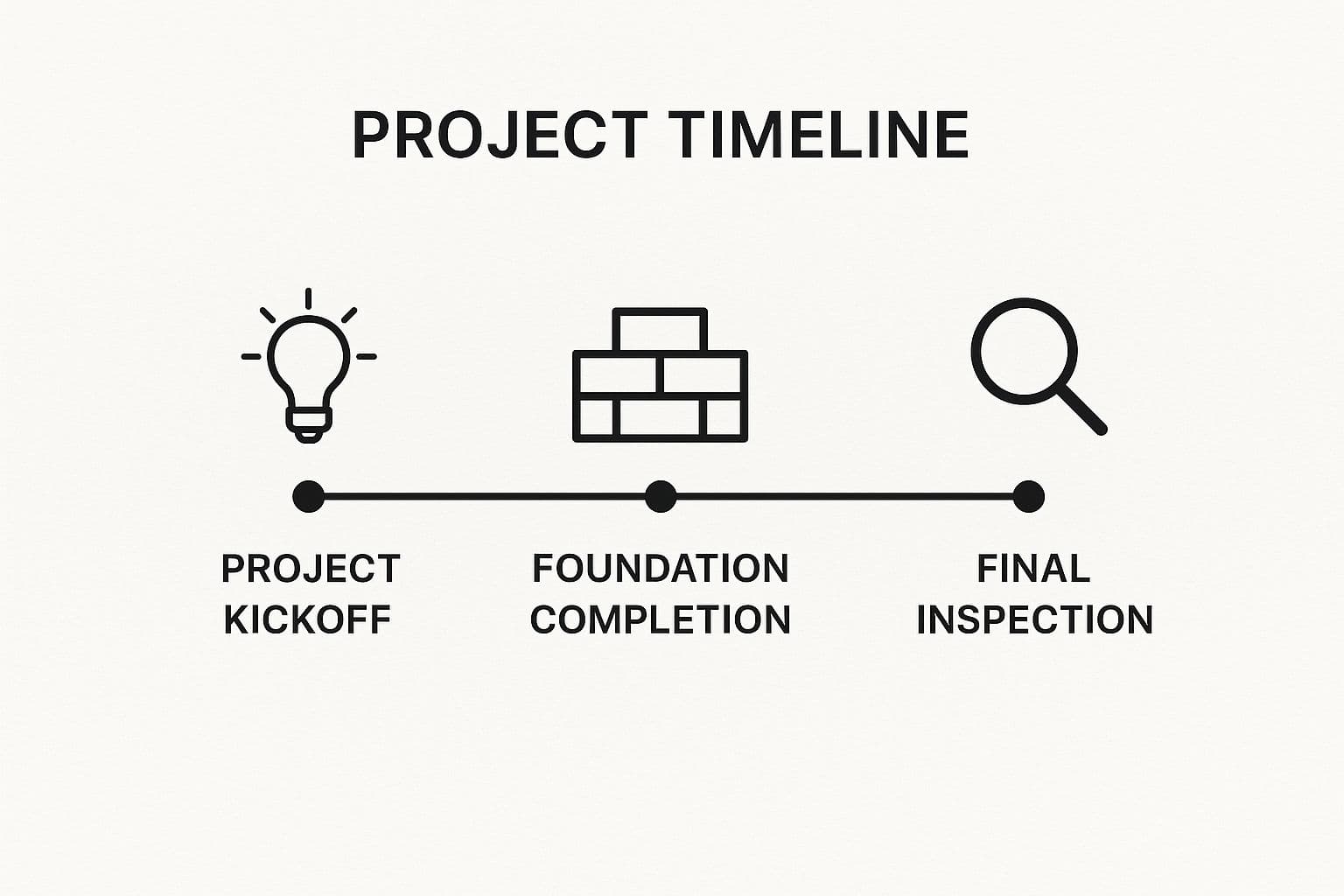Find the perfect project summary sample for your industry. Explore 6 detailed templates for construction, software, business, marketing, and more.
July 1, 2025 (5mo ago)
6 Project Summary Sample Formats for 2025 Success
Find the perfect project summary sample for your industry. Explore 6 detailed templates for construction, software, business, marketing, and more.
← Back to blog
A well-crafted project summary is the cornerstone of successful project management. It is more than just a document; it is a strategic tool for securing buy-in, aligning stakeholders, and ensuring everyone understands a project's core purpose, scope, and objectives. Whether you're pitching to executives, applying for a grant, or kicking off a complex initiative, the right summary can make all the difference between clarity and confusion. A powerful summary communicates value quickly and effectively, setting the stage for success from the very beginning.
This guide moves beyond generic templates to provide a detailed breakdown of effective project communication. We will dissect six distinct project summary sample** formats, each tailored to a specific industry and goal. You won't just see examples; you will get a deep strategic analysis, actionable takeaways, and replicable methods for each one. Our goal is to equip you with a robust framework for crafting summaries that not only inform but also persuade.
By exploring these varied examples, from software development to non-profit grant proposals, you will learn how to structure your own summaries to capture attention, convey critical information, and drive your projects forward with clear, unified direction.
1. Construction Project Summary Template
A construction project summary is a high-level, comprehensive document that encapsulates all critical aspects of a building or infrastructure project. Tailored for an industry where precision, safety, and regulatory adherence are paramount, this type of summary serves as a vital communication tool for stakeholders, including investors, clients, regulatory bodies, and internal teams. It moves beyond a simple status update, providing a structured overview of scope, budget, timelines, resource allocation, and risk management.
For organizations like the American Institute of Architects (AIA) and the Associated General Contractors of America (AGC), this format is standard practice. It ensures clarity on complex deliverables, from a commercial high-rise to a municipal infrastructure upgrade. This project summary sample is essential for securing approvals, aligning diverse teams, and maintaining project momentum.
Strategic Breakdown
The power of this summary lies in its ability to translate intricate project details into an accessible format. It uses a combination of concise text, financial data, and visual aids to convey the project's health and trajectory.
- Scope & Objectives: Clearly defines project boundaries, key deliverables (e.g., square footage, number of units), and the primary goals, such as meeting a specific housing demand or improving transportation flow.
- Budget & Financials: Presents a transparent view of the total budget, expenditures to date, and forecasted costs. This section is crucial for investors and financial controllers.
- Timeline & Milestones: Outlines the project schedule with key phases and critical milestones. This is often where visual aids are most effective.
This infographic illustrates a simplified timeline for a commercial building project, highlighting key checkpoints from start to finish.

Visualizing the project's major phases provides an immediate understanding of progress and what critical stages are upcoming.
Actionable Takeaways
To create an effective construction summary, focus on clarity and evidence. Integrate visual elements like Gantt charts for scheduling and site plans to illustrate scope. Prominently feature sections on regulatory compliance and environmental impact assessments, as these are often non-negotiable for project approval. For deeper insights into managing and reporting on these timelines, you can explore best practices for tracking project progress.
2. Software Development Project Summary Format
A software development project summary is a specialized document that bridges the gap between technical complexity and business objectives. It distills an entire software project, from an enterprise platform implementation to a mobile app launch, into a clear, digestible format. This summary is indispensable for communicating with a diverse audience, including C-level executives, investors, product owners, and development teams. It translates technical jargon into strategic business value, ensuring all stakeholders are aligned on goals, progress, and outcomes.

Popularized by platforms like Atlassian and Microsoft through their Jira and Azure DevOps templates, this format is central to Agile methodologies. It provides a living snapshot of the project's health. This project summary sample for software development is crucial for sprint planning, resource allocation, and stakeholder reporting, especially in fast-paced, iterative environments.
Strategic Breakdown
The strength of a software development summary is its ability to present multifaceted information logically. It organizes technical specifications, user-centric requirements, and deployment logistics into a cohesive narrative that supports informed decision-making.
- User Requirements & Stories: This section moves beyond technical features to define the "why" behind the software. It outlines the problems the software solves for the end-user, often framed as user stories (e.g., "As a user, I want to reset my password so I can access my account if I forget it").
- Technical Stack & Architecture: Briefly describes the technologies, programming languages, and frameworks used. It also outlines the high-level system architecture, including key components and how they interact, which is vital for assessing scalability and maintainability.
- Development Methodology & Sprints: Clarifies the project management approach, such as Agile, Scrum, or Kanban. It often includes a summary of current and upcoming sprints, key deliverables for each, and team velocity, providing a clear view of development momentum.
Actionable Takeaways
To create a powerful software summary, prioritize clarity for non-technical stakeholders without sacrificing essential technical detail. Use visual aids like wireframes or mockups to illustrate user interfaces and workflows. Incorporate metrics from user testing and a summary of feedback to ground the project in real-world validation. Clearly document integration points with existing systems and APIs, as this is a common area of risk. For project managers overseeing multiple software initiatives, understanding how to synthesize this information effectively is key. You can find valuable strategies for managing multiple projects simultaneously.
3. Executive Business Project Summary
An executive business project summary is a high-level, strategic document engineered for senior leadership and board-level audiences. Its primary purpose is to secure buy-in, funding, or strategic approval by focusing on business impact rather than operational minutiae. This summary distills a complex project, such as a digital transformation or market expansion, into its most essential components: ROI, strategic alignment, and key performance indicators (KPIs).
This format, popularized by consulting firms like McKinsey & Company and prominent in Harvard Business School case studies, prioritizes brevity and impact. It answers the "why" and "what's in it for us" before delving into the "how." For a Fortune 500 company evaluating a new product launch or a cost-reduction initiative, this project summary sample is the critical first step in the decision-making process.
Strategic Breakdown
The strength of an executive summary lies in its ability to communicate value quickly and persuasively. It strips away technical jargon and operational complexity to present a clear, compelling business case. This is achieved by structuring the narrative around core business drivers.
- Business Problem & Opportunity: Leads with a concise definition of the market problem the project solves or the strategic opportunity it captures. This immediately frames the project's relevance.
- Financial Impact & ROI: Quantifies the expected business outcomes using clear financial metrics like Net Present Value (NPV), Internal Rate of Return (IRR), and payback period. This section directly addresses the primary concern of executives and investors.
- Strategic Alignment: Explicitly connects the project's goals to the organization's overarching strategic objectives. This demonstrates how the initiative supports the company's long-term vision.
Actionable Takeaways
To craft a powerful executive summary, begin with the conclusion. State the business case and your recommendation upfront. Support this with compelling data, focusing on financial projections and market analysis. Keep the language direct, confident, and free of ambiguity. It is crucial to anticipate and address potential questions about risks and competitive landscape within the summary. Building a robust framework for these high-stakes conversations is a key element of project leadership, which is further detailed in a well-structured project communications plan.
4. Academic Research Project Summary
An academic research project summary is a rigorous, highly structured document designed to convey the essence of a scholarly investigation. Primarily used for grant applications, dissertation proposals, or submissions to academic journals, this summary must articulate the project's intellectual merit and broader impact. It serves as the primary tool for convincing review boards, funding agencies, and academic peers of the research's value, feasibility, and originality.
Organizations like the National Science Foundation (NSF) and the National Institutes of Health (NIH) have institutionalized this format, setting the standard for academic rigor. Unlike business summaries that focus on ROI, this project summary sample prioritizes the contribution to a body of knowledge. It communicates the research question, methodology, and expected outcomes with precision, ensuring that the project's scholarly foundation is immediately apparent.
Strategic Breakdown
The strength of an academic summary is its logical, evidence-based structure. It methodically builds a case for the research, guiding the reader from the established literature to the proposed contribution. Each section is designed to answer a specific question a reviewer might have.
- Problem Statement & Research Gap: Clearly articulates the specific problem the research addresses and identifies the gap in the existing literature that the project aims to fill. This establishes the project's relevance and necessity.
- Methodology & Approach: Provides a detailed yet concise description of the research methods to be used, whether quantitative, qualitative, or mixed-methods. It justifies why this approach is the most appropriate for answering the research question.
- Expected Outcomes & Scholarly Contribution: Outlines the anticipated results and explains how they will advance the field of study. This section highlights the project's originality and its potential to generate new knowledge or theories.
This structured format ensures that reviewers can quickly assess the project's scientific rigor and potential impact, which is critical in competitive funding environments.
Actionable Takeaways
To craft a compelling academic research summary, strict adherence to the target institution's or journal's guidelines is non-negotiable. Clearly define all key terms and avoid jargon where possible, or explain it if necessary. The justification for your methodology is as important as the method itself, so dedicate space to explaining why your chosen approach is sound. For those preparing proposals for major funding bodies, it is beneficial to explore resources on grant writing, such as the guidance provided by the NIH on writing a grant application.
5. Marketing Campaign Project Summary
A marketing campaign project summary is a dynamic, high-impact document that outlines the strategic plan for a specific marketing initiative. Designed for advertising agencies, in-house marketing teams, and brand managers, it aligns all stakeholders around a common set of goals, creative direction, and performance metrics. This summary is crucial for translating brand objectives into a tangible action plan, ensuring every activity, from a social media post to a national TV spot, serves a unified purpose.
Organizations like the American Marketing Association (AMA) and the Association of National Advertisers (ANA) champion this format. It provides essential clarity for complex initiatives such as a new product launch or a major brand repositioning. This project summary sample is the backbone for securing budgets, aligning creative and media teams, and demonstrating potential return on investment (ROI) to executive leadership.

Strategic Breakdown
The strength of a marketing summary is its ability to blend creative vision with data-driven strategy. It uses a compelling narrative, supported by audience insights and financial projections, to build a case for the campaign's success.
- Objectives & KPIs: Defines the campaign's primary goal (e.g., generate 1,000 marketing qualified leads, increase brand awareness by 15%) and the Key Performance Indicators (KPIs) that will measure success, like conversion rates or cost per acquisition (CPA).
- Target Audience & Creative Strategy: Details the specific audience persona, including their pain points and media habits. It then outlines the core message and creative concept designed to resonate with that group.
- Channel Mix & Budget: Breaks down how the budget will be allocated across various channels, such as paid search, social media, content marketing, and events. This section justifies the media plan and sets spending expectations.
Actionable Takeaways
To build a persuasive marketing campaign summary, prioritize clarity on outcomes and audience. Clearly define success metrics upfront so there is no ambiguity about what the campaign needs to achieve. Include a competitive analysis to show how your strategy positions the brand effectively in the marketplace. For campaigns that blend digital and traditional media, like those detailed by marketing leaders at HubSpot, map the customer journey across all touchpoints to create a seamless experience.
6. Non-Profit Grant Project Summary
A non-profit grant project summary is a persuasive and highly structured document created to secure funding from foundations, government bodies, or corporate philanthropies. Unlike internal corporate summaries, this format is an external-facing tool that must align perfectly with a funder's specific mission and guidelines. It blends compelling narrative with hard data to make a case for social return on investment. The primary goal is to convince grantmakers that the proposed project is a critical, well-planned, and sustainable solution to a documented community problem.
This type of summary is a cornerstone practice for organizations like the Bill & Melinda Gates Foundation and the Ford Foundation, which demand rigorous evidence of need, capacity, and potential impact. This project summary sample is not just about reporting; it’s about inspiring confidence and demonstrating stewardship. From an educational program for at-risk youth to an environmental conservation initiative, its clarity and persuasiveness directly determine whether a vital community project gets funded.
Strategic Breakdown
The strength of a non-profit grant summary is its ability to connect a human story to a strategic plan. It must answer the funder's core questions: Why this project? Why this organization? And why now? It uses a careful balance of emotional appeal and logical argumentation, backed by verifiable data.
- Problem Statement & Needs Assessment: Clearly articulates the community problem using data (e.g., local poverty rates, literacy statistics) and compelling anecdotes. This section establishes the urgency and relevance of the project.
- Outcomes & Measurable Impact: Moves beyond listing activities to defining specific, measurable, achievable, relevant, and time-bound (SMART) goals. It explains how success will be tracked, such as "increase high school graduation rates by 15% among program participants within three years."
- Organizational Capacity & Sustainability: Showcases the non-profit's track record, expertise, and community partnerships. It must also present a clear plan for how the project will continue to operate after the grant funding ends, demonstrating long-term viability.
Actionable Takeaways
To create a winning grant summary, focus on alignment with the funder's priorities. Customize each summary to reflect the language and focus areas mentioned in the grant application guidelines. Use powerful visuals like a logic model to illustrate the connection between your inputs (staff, funds) and your long-term impact. Incorporate direct quotes or short testimonials from community members to add an authentic, human element. For a deeper understanding of how to structure these proposals, resources from organizations like the Council on Foundations provide invaluable guidance on best practices.
Project Summary Sample Comparison
| Project Summary Type | Implementation Complexity 🔄 | Resource Requirements ⚡ | Expected Outcomes 📊 | Ideal Use Cases 💡 | Key Advantages ⭐ |
|---|---|---|---|---|---|
| Construction Project Summary | High - detailed sections and regulatory compliance needed | High - requires extensive data collection & updates | Comprehensive project overview, supports approvals & funding | Large-scale construction, infrastructure projects | Standardized, comprehensive, facilitates regulatory approvals |
| Software Development Project Summary | Medium-High - technical specs and frequent agile updates | Medium - technical expertise and continuous updates | Balanced technical & business communication, supports iterative dev | Software dev, cloud projects, API integrations | Scalable, supports DevOps/CI-CD, cross-functional communication |
| Executive Business Project Summary | Medium - high-level, concise, less technical detail | Low-Medium - focus on business metrics and strategy | Strategic alignment, executive buy-in, funding approval | Executive board presentations, strategic decisions | Concise, focuses on business impact, quick decision support |
| Academic Research Project Summary | High - rigorous methodology and formatting standards | High - requires detailed research design and justifications | Scholarly contribution, funding support, academic rigor | Grant proposals, academic research projects | Meets academic standards, supports peer review and funding |
| Marketing Campaign Project Summary | Medium - strategic and creative elements with measurable ROI | Medium - marketing data and creativity | Measurable marketing objectives, ROI tracking | Marketing campaigns, advertising projects | Industry-aligned, measurable outcomes, multi-channel coordination |
| Non-Profit Grant Project Summary | High - multiple stakeholder needs and funder-specific formats | High - community data, detailed impact & budget | Social impact, community benefit, sustainability | Non-profit funding proposals, social initiative grants | Emphasizes social impact, sustainability, funder compliance |
From Sample to Success: Implementing Your Project Summary
We’ve journeyed through a diverse landscape of project summary samples, from the tangible world of construction to the abstract realm of software development and the high-stakes environment of executive proposals. The core lesson is clear: a project summary is not a one-size-fits-all document. Its true power lies in its adaptability and its strategic alignment with its intended audience and purpose.
The samples provided, whether for a marketing campaign or a non-profit grant, share a common DNA. They all distill complexity into clarity, transforming a web of tasks, goals, and data into a compelling, easy-to-digest narrative. This is the fundamental purpose of any project summary sample you use as a foundation.
Synthesizing the Core Strategies
Across all the examples, three core principles emerged as critical for success. Mastering these will elevate your summaries from simple reports to influential communication tools.
-
Audience-Centric Framing: The executive summary for a business project prioritized ROI and strategic alignment, while the academic summary focused on methodology and contribution to the field. This highlights the most crucial rule: always write for your reader. Before you type a single word, define who you are trying to inform or persuade and tailor your language, data, and focus accordingly.
-
The Power of Quantifiable Data: Vague statements have no place in a strong project summary. Notice how the best examples used concrete metrics, such as "reduce customer churn by 15%" or "secure $250,000 in funding." Numbers build credibility and provide a clear, objective measure of success, leaving no room for ambiguity.
-
Clarity Through Structure: Every effective summary, regardless of industry, follows a logical structure. They begin with the high-level purpose (the "why"), move to the key objectives and scope (the "what"), and conclude with the expected outcomes and timeline (the "how" and "when"). This predictable format helps busy stakeholders quickly find the information they need.
Your Actionable Path Forward
Moving from theory to practice is the final, most important step. Don't just save these templates; activate them. Use the diverse examples in this article as a strategic toolkit.
- Start with a "Best-Fit" Template: Select the project summary sample that most closely matches your current needs.
- Customize with Intent: Borrow elements from other samples. Perhaps the visual timeline from the marketing campaign summary would enhance your software development report. Maybe the clear risk assessment from the construction template could strengthen your executive proposal.
- Iterate and Refine: Your first draft is just the beginning. Share it with a trusted colleague or stakeholder. Ask them: "After reading this for 60 seconds, what is the key takeaway?" If their answer doesn't align with your goal, it's time to revise for clarity and impact.
Ultimately, a well-crafted project summary is more than just an administrative task; it's a leadership tool. It aligns teams, secures resources, and builds confidence among stakeholders. By mastering the art of the summary, you are not just documenting work-you are actively paving the way for your project's success.
Ready to transform these samples into powerful, collaborative workflows? Fluidwave provides the perfect platform to draft, manage, and share your project summaries. Use our customizable boards to track your summary from initial draft to final approval, ensuring every stakeholder is aligned and every detail is perfect. Start building better summaries today with Fluidwave.
Focus on What Matters.
Experience lightning-fast task management with AI-powered workflows. Our automation helps busy professionals save 4+ hours weekly.